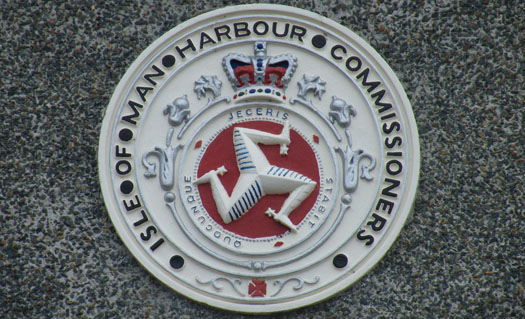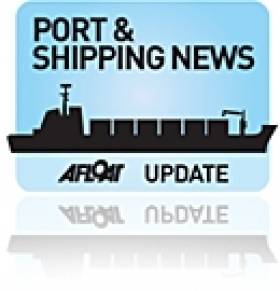Displaying items by tag: Mezeron Ltd Freight Services
Manx Shipping Scene: Not Just the Preserve of Douglas
#ManxShippingScene – Outsiders could easily conclude that the Manx capital, Douglas is exclusively where all shipping activity takes place given the traditional 'steam-packet' links between the island and the UK and Ireland, not so, head northwards to Ramsey, writes Jehan Ashmore.
Before, we do just a little background to The Isle of Man Steam Packet Co which they claim to be the oldest continually operating passenger shipping company in the world, having begun operations in 1830.
The company, also known simply as the 'steam-packet', remains very much at the heart of Manx shipping scene and playing a pivotal role as the economic, cultural and social life-line in operating the main routes to England and seasonal services to Dublin and Belfast.
While the above combined passenger, car-carrying and freight services of the Steam Packet all converge in Douglas from where there was an attempt of a rival newcomer entering the market this Spring, yet this did not materialise. Having said that, other existing services albeit freight-only operate regularly and further northward along the coast in Ramsey.
However, since the demise of the Ramsey Steamship Co. in its centenary year last year, sadly only one other 'cargo-only' company serves the island, that been Mezeron Limited Freight Services also based from the homeport of Ramsey.
As previously reported on Afloat.ie last year, the Ramsey Steamship celebrated the centenary anniversary with their Ben Maye, which was chartered by Irish trade unions, where notably SIPTU was joined by UK counterparts to mark another event of 100 years ago, the Lockout of 1913.
The Lockout 1913 'commemorative' voyage from Liverpool, was also where the ship's owners had their own centenary celebrations held at Liverpool Cruise Terminal before she set off from Merseyside to the Liffey quays.
The Isle of Man based coastal cargo shipping company was wounded-up because of a £1m pension liability, which led to the sale of the short-sea coasters, the other been the larger Ben Varrey.
The 100-year old company, which traded, to many a small harbour and port throughout the Irish Sea and beyond was sold in late 2013 to Kent based shipowner, Angel Shipping Ltd. The pair of coasters still retain their 'Ben' names and are operated and managed by a wholly-owned subsidiary of Angel, Absolute Shipping Ltd.

Despite the sale of this famous Manx company, the coasters continue to serve the island and notably their former homeport. This is particularly pleasing to those who have an affinity with the business of coastal shipping, particularly small vessels trading to and from small harbours and ports within the Irish Sea.
In the case of Ramsey, commercial ships are outnumbered by other or smaller leisure craft on the Sulby River, which flows into Ramsey Bay.
These 'other craft' based in the north-eastern port are a fleet of trawlers and yachts that lie along the tidal stretch of the Sulby River, where the Vikings came in the 14th century. The name 'Ramsey' is derived from the Norse word 'Hramns-ey' meaning 'Raven's Isle' this is a reference to a former island at the mouth of the Sulby.
From the Vikings longboats to the present day, where there is a marine engineering boatyard on the far side of the river which can be accessed by roadbridge and also crossed using a swing-bridge, albeit currently under renovation.
Local fishing fleet moored within the harbour at Ramsey
While the Ramsey Steamship are longer in existence, Ramsey, still has a single-shipowner, that been Mezeron Limited Freight Services, whose small coastal general cargoship, Silver River (1963/277grt) was not in port during my visit last week to the Isle of Man.
The classic lines of the Silver River were however not to be seen in Manx waters let alone her usual 'liner' trading services between Ramsey-Belfast and Ramsey-Glasson Dock, where the Lanchashire port also has a marina. Instead the veteran vessel is undergoing a class survey work in Poland at the Morska Yard in Swinoujscie.
Taking her place on services to and from Ramsey was the Isis (1978/674grt), which as pictured was berthed in front of the Mezeron office. The former Channel Islands coaster had traded with Alderney Shipping and originally named David Dorman.
She is currently owned by Great Glen Shipping based in Fort William and is chartered out to Mezeron. While berthed in Ramsey, the foremast flew the Scottish soltaire and at the stern was the Red Ensign of the Douglas registered coaster.
It is expected that Silver River which has been in Manx service since 1986, will resume services from Ramsey next month for Mezeron which has been operating for more than three decades since establishment in 1983.
Among the cargo supplies to support island life are bagged cement, fertiliser and 20-ft (TEU) containers. On rare occasions, the company call to Peel on the island's west coast for the explosives trade.
As for the 'liner' services of Mezeron's two-routes, the Isis make a scheduled arrival to Ramsey from Belfast on Wednesday's and on Thursdays, (as of earlier today) she discharged her cargo.
This late afternoon she was bound for Glasson Dock, where the coast of Lancashire can be seen from Ramsey.






























































